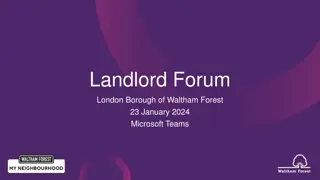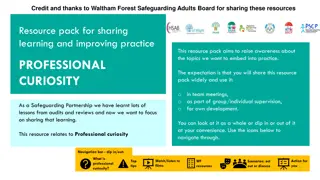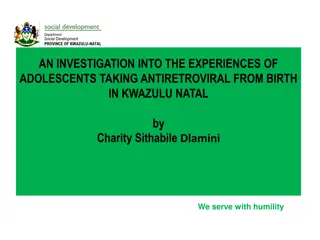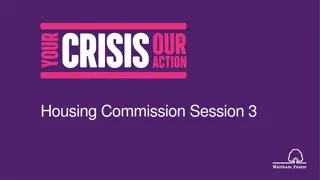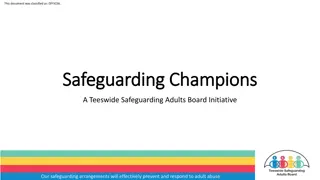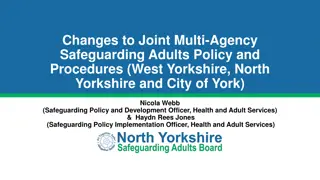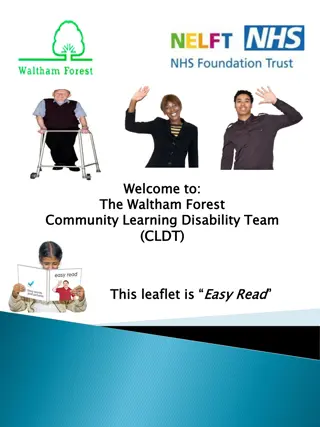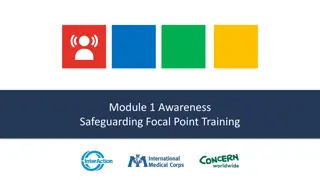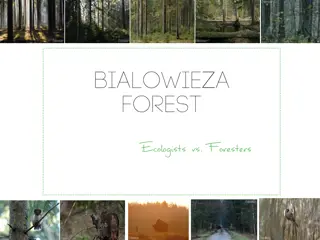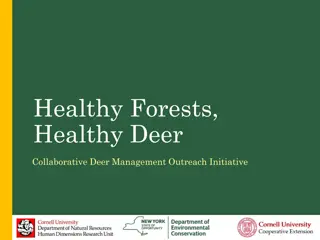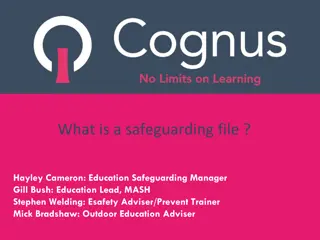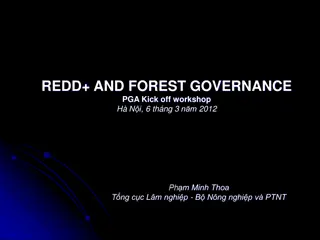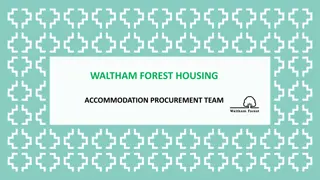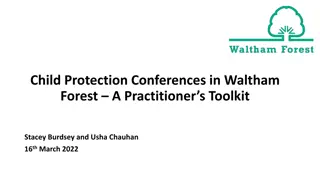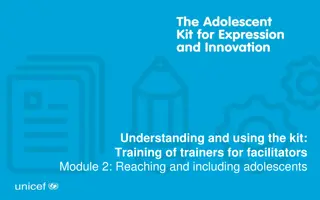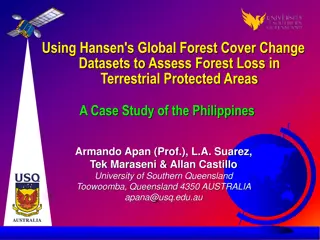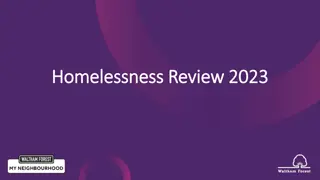Resource Pack for Safeguarding Adolescents: Enhancing Practice in Waltham Forest
This resource pack aims to promote a culture of understanding and responsiveness in safeguarding adolescents in Waltham Forest. It emphasizes valuing diverse experiences, considering both positive and negative risks, prioritizing adolescent needs, and recognizing constrained choices. Through various tools and resources, it encourages collective improvement in safeguarding practices for the well-being of young individuals.
Download Presentation

Please find below an Image/Link to download the presentation.
The content on the website is provided AS IS for your information and personal use only. It may not be sold, licensed, or shared on other websites without obtaining consent from the author. Download presentation by click this link. If you encounter any issues during the download, it is possible that the publisher has removed the file from their server.
E N D
Presentation Transcript
Resource pack for sharing learning and improving practice Safeguarding SAFETY SAFEGUARDING WELLBEING Strategic Partnership Boards SAFETY SAFEGUARDING WELLBEING The expectation is that you will share this resource pack widely and use it: Resource pack for sharing learning and improving practice SAFEGUARDING ADOLESCENTS Adolescents This resource pack aims to help raise awareness about the Waltham Forest approach to safeguarding our children and young people through a shared set of values and principles for work in this area. As a partnership, we are committed to improving our collective response to adolescent risk. in team meetings as part of group/individual supervision for your own development You can look at it as a whole or dip in or out of it at your convenience. Click on the icons on the grey tool bar below and throughout the resource to work through at your own pace. Navigation bar - dip in/out: Home Help Presentation with checklist Chat Presentation with media Drama List Warning Act Resources Watch/listen Top tips Discuss Home About Action for you Act Resources Top tips Watch/listen Discuss Home About Action for you
WHAT is thesafeguarding adolescents approach? Our vision In Waltham Forest we want to embed a culture of understanding about the complexity of safeguarding adolescents where we: VALUE the diverse range of experiences of the adolescents in Waltham Forest and respond to the needs of adolescents of all genders, ethnicities, sexual identities and beliefs, and those who are disabled. CONSIDER the positive and negative impact of risks adolescents take in exploring their growing independence SEEadolescents as children first UNDERSTAND developmental needs of adolescents needs and risks for adolescents with special educational needs or disabilities (SEND) influences in adolescent lives, including those outside the family context Navigation bar - dip in/out: MAINTAINfocus on the risks that adolescents are exposed to in contexts outside the family. Respond with the right conversation, right action at the right time RECOGNISE constrained choices that adolescents may feel powerless to avoid Home Help Presentation with checklist Chat End Presentation with media Drama List Warning Resources Watch/listen Top tips Discuss Home About Action for you Act Next slide Resources Top tips Watch/listen Discuss Home About Action for you Act Next slide
WHAT is Safeguarding adolescents? Constrained Choice Decision chart Children First X Child with balloon X There are some important aspects of our safeguarding adolescents approach. Click next slide or on each icon to find out more Constrained Choice Children First ACEs (adverse childhood experiences) Brain in head ACEs (adverse childhood experiences) Contextual Safeguarding City Park scene Reachable Moments Trauma-Informed Lightbulb and gear Venn diagram Contextual Safeguarding Open hand Reachable Moments Trauma- Informed Navigation bar - dip in/out: Home Help Presentation with checklist Chat End Presentation with media Drama List Warning Resources Watch/listen Top tips Discuss Home About Action for you Act Next slide Resources Top tips Watch/listen Discuss Home About Action for you Act Next slide
WHAT is CONTEXTUAL SAFEGUARDING? Contextual safeguarding is an approach to understanding and responding to adolescents experiences of significant harm outside of their homes and beyond their families. It recognises that the relationships adolescents form in neighbourhoods, schools and online can feature violence and abuse. Parents have little influence over these contexts, and adolescents' experiences of extra-familiar abuse can undermine child- parent relationships. Neighbourhood This short video from The Contextual Safeguarding Network provides an overview of contextual safeguarding and what it means in practice for different social contexts. School Peer Group Home Child Navigation bar - dip in/out: Home Help Presentation with checklist Chat End Presentation with media Drama List Warning Child with balloon Resources Watch/listen Top tips Discuss Home About Action for you Act Next slide Resources Top tips Watch/listen Discuss Home About Action for you Act Next slide Decision chart Lightbulb and gear City Brain in head Venn diagram Open hand Park scene Puzzle X X
WHAT do we mean by CHILDREN FIRST? It is crucial that we see adolescents as children first. It may be tempting to view/treat them as mini-adults especially those who act older or are older. Remember they are still a child. Seeing an adolescent as a person makes it easier for us to see the wider context. We have adopted seven principles to improve our responses to adolescent risk: See the person Not the behaviour, actions or offence There is much more to an adolescent than their behaviour. Be aware of your own emotional responses. 1. Work with adolescent development particularly perception, autonomy, aspiration, and skills 2. Work with adolescents as assets and resources e.g. draw on strengths to build confidence and resilience 3. Promote supportive relationships between adolescents and their family and peers 4. Prioritise supportive relationships between adolescents and key practitioner(s) through service design 5. Take a holistic approach both to adolescents and the risks they face e.g. avoid labelling adolescents according to risks 6. Ensure services are accessible and advertised respond to adolescent autonomy, advertise benefits and provide outreach 7. Equip and support the workforce Navigation bar - dip in/out: Home Help Presentation with checklist Chat End Presentation with media Drama List Warning Child with balloon Resources Watch/listen Top tips Discuss Home About Action for you Act Next slide Resources Top tips Watch/listen Discuss Home About Action for you Act Next slide Decision chart Lightbulb and gear City Brain in head Venn diagram Open hand Park scene Puzzle X X
WHAT are ACEs? Adverse childhood experiences or ACEs are traumatic events occurring before the age of 18 years, that can have negative lasting effects on health and behaviour. High or frequent exposure to ACEs, without the support of a trusted adult can lead to toxic stress. Public Health Wales has done work to raise awareness of ACEs and this short animation film developed with Darwen Local Authority provides an introduction to the subject Responses by the child to trauma are attempts to survive and make meaning Relationships matter and reachable moments can support healing and change ACEs can lead to mental illness and health harming behaviours ACEs cause stress and trauma Navigation bar - dip in/out: Home Help Presentation with checklist Chat End Presentation with media Drama List Warning Child with balloon Resources Watch/listen Top tips Discuss Home About Action for you Act Next slide Resources Top tips Watch/listen Discuss Home About Action for you Act Next slide Decision chart Lightbulb and gear City Brain in head Venn diagram Open hand Park scene Puzzle X X
WHAT does TRAUMA-INFORMED mean? Research has shown that experiences of trauma can have a significant impact on adolescent brain development. In general, trauma can be defined as a psychological, emotional response to an event or an experience that is deeply distressing or disturbing. Trauma can be thought of as an umbrella term under which Adverse Childhood Experiences (ACEs) belongs. Some adolescents will have a traumatic response to risk and/or harm that they have experienced. Trauma is subjective - an event that is traumatic for one person may not be for another. Individuals should be able to develop their own narratives. Now what? What? So what? An understanding of trauma helps practitioners to recognise that rather than being completely in control of decision-making, adolescents often make constrained choices developed adults who can make choices, over which they have full control. A trauma-informed approach starts with a premise of asking What has happened to you? as opposed to What is wrong with you? compared to Navigation bar - dip in/out: Home Help Presentation with checklist End Presentation with media Drama List Warning Child with balloon Resources Watch/listen Top tips Discuss Home About Action for you Act Next slide Resources Top tips Watch/listen Discuss Home About Action for you Act Next slide Decision chart Lightbulb and gear City Brain in head Venn diagram Open hand Park scene Puzzle X X
WHAT are REACHABLE MOMENTS? These are the occasions when a child comes into contact with a service at a time when they are vulnerable. This is a reachable moment because it gives us an opportunity to make a connection with that child, offering a chance to actually reach them. Why are reachable moments so important? Making a connection in a reachable moment could potentially change the direction of travel for a child and make a difference to their whole life. Example A child is found in a county lines situation and arrested. They are far from home, on their own and feeling afraid of what is going to happen to them. The child is fearful of the criminal justice system, how their carers/parents are going to react and the organised crime group which is exploiting them with whom they may also have drug debt. This presents a reachable moment for any professional now involved. Due to the fear and vulnerability this child is experiencing it may be more likely that they positively receive offers of help and support. Our role is to make sure that offer of support is about the right conversation, with the right action, at the right time Navigation bar - dip in/out: Home Help Presentation with checklist Chat End Presentation with media Drama List Warning Child with balloon Resources Watch/listen Top tips Discuss Home About Action for you Act Next slide Resources Top tips Watch/listen Discuss Home About Action for you Act Next slide Decision chart Lightbulb and gear City Brain in head Venn diagram Open hand Park scene Puzzle X X
WATCH/LISTEN to these films Here is a selection of films that provide more information and further opportunity to explore some of the topics covered in this resource pack Reachable moments Ian Wright talks about a teacher who made a difference to his life Contextual Safeguarding Dr Carlene Firmin explains more The Waltham Forest approach to Safeguarding Adolescents Navigation bar - dip in/out: Home Help Presentation with checklist Chat End Presentation with media Drama List Warning Resources Watch/listen Top tips Discuss Home About Action for you Act Next slide Resources Top tips Watch/listen Discuss Home About Action for you Act Next slide
WATCH/LISTEN to these films Trauma informed & trauma More on ACEs ACEs: Impact on brain, body and behaviour ACEs - NHS Health Scotland NSPCC: How a child's brain develops through early experiences From Jacob Ham, in simple terms Navigation bar - dip in/out: Home Help Presentation with checklist Chat Presentation with media Drama List Warning Resources Watch/listen Top tips Discuss Home About Action for you Act Resources Top tips Watch/listen Discuss Home About Action for you Act
USE these local and national resources Internet National report: SAFEGUARDING CHILDREN AT RISK OF CRIMINAL EXPLOITATION National report: SAFEGUARDING CHILDREN AT RISK OF CRIMINAL EXPLOITATION Document A guide to: THRESHOLDS for CHILDREN Practice manual: BUILDING RESILIENCE Resources: CONTEXTUAL SAFEGURDING NETWORK Guidance for SAFEGUARDING ADOLESCENTS Checklist Checklist Closed book Practice manual: BUILDING RESILIENCE Resources: CONTEXTUAL SAFEGURDING NETWORK A guide to: THRESHOLDS for CHILDREN Guidance for SAFEGUARDING ADOLESCENTS Internet Workflow Workflow Teacher Government guidance: COUNTY LINES Resources from Gloucestershire: ACEs Information: CHILD CRIMINAL EXPLOITATION COUNTY LINES CSE resources: NWG CSE resources training: SEEN AND HEARD Checklist Information: CHILD CRIMINAL EXPLOITATION & COUNTY LINES Government guidance: COUNTY LINES Resources from Gloucestershire: ACEs CSE resources: NWG CSE resources & training: SEEN AND HEARD Internet Guidance: APPROPRIATE LANGUAGE More toolkits guidance: CCE/CSE Criminal exploitation: STAGES OF RECRUITMENT Toolkit: COUNTY LINES Resources: STRATEGIC PARTNERSHIPS WEBPAGES Checklist Checklist Document Checklist Checklist Criminal exploitation: STAGES OF RECRUITMENT Resources: STRATEGIC PARTNERSHIPS WEBPAGES Guidance: APPROPRIATE LANGUAGE More toolkits & guidance: CCE/CSE Toolkit: COUNTY LINES Navigation bar - dip in/out: Home Help Presentation with checklist Chat Presentation with media Drama List Warning Resources Watch/listen Top tips Discuss Home About Action for you Act Resources Top tips Watch/listen Discuss Home About Action for you Act
TOP TIPS: opportunities to support The role of trusted adult is to build a relationship so that adolescents feel able to talk. This approach should not be used to pry into adolescents personal lives. Many adolescents go through a period where they need independence and personal space and may seem to communicate less. They may be reluctant to provide details about their friends or about places where they are spending time, they should not be pushed by intrusive questions. Being aware of, and responsive to, cultures within your agency which may be perpetuating harmful environments e.g. does your agency have policy which outlines how you would respond to issues like sexual harassment, bullying and prejudice? All practitioners have opportunities in every day work with adolescents to identify risks outside the family home: Take note of themes and trends that are coming to notice in your agency. Organisation & culture Trends Listening out for locations where adolescents who are at risk say that they are spending time Places Think about whether your interaction with an adolescent could be that REACHABLE MOMENT Listening out for names of peers or adults with whom adolescents mention they are spending time People Navigation bar - dip in/out: Home Help Presentation with checklist Chat End Presentation with media Drama List Warning Resources Watch/listen Top tips Discuss Home About Action for you Act Next slide Resources Top tips Watch/listen Discuss Home About Action for you Act Next slide Dance steps Ear Cheers Body builder Ribbon
TOP TIPS: EFFECTIVE ENGAGEMENT The starting point for all practitioners if they are concerned about an adolescent should be a quality conversation. Here are some top tips to support effective engagement with adolescents: LISTEN, LISTEN, LISTEN The single most important principle is to really hear what the adolescent has to say ACKNOWLEDGEMENT Thank adolescents for being able to talk to you. Listen to what they have to say, and later support them ENVIRONMENT Give time and space. Pick the right place. AWARENESS Stay alert! Keep your eyes, ears and body language open to what the adolescent has to say, without judging, being shocked, commenting or advising (in the first instance) SENSITIVITY Describe areas of concern sensitively with adolescents. Consider the pace and number of questions ADJUSTMENTS Adapt your communication accordingly to needs of adolescents with SEND or work with an advocate who knows them well Navigation bar - dip in/out: Home Help Presentation with checklist Chat End Presentation with media Drama List Warning Resources Watch/listen Top tips Discuss Home About Action for you Act Next slide Resources Top tips Watch/listen Discuss Home About Action for you Act Next slide Dance steps Ear Cheers Body builder Ribbon
TOP TIPS: EFFECTIVE ENGAGEMENT FEEDBACK Give feedback that is specific and focused on desired behaviours CURIOSITY Find out what matters to them. What are their hopes and dreams? Their personal strengths? Learn about the assets around them such as peers, family, friends, activities they enjoy or networks they are part of SEE READINESS TO CHANGE Approach early engagements with curiosity and look for signs that they are ready to change. AVOID CORRECTION Instead of questioning the decision, question how they arrived at their thinking START NEUTRAL Don t discuss the consequences of their behaviour during early stages of engagement, unless there are clear and immediate child protection concerns WHAT S IN IT FOR THEM? Listen out for motivation to gain an understanding of what they wants CUT THE JUDGEMENT Avoid phrases like I m disappointed with you Navigation bar - dip in/out: Home Help Presentation with checklist Chat End Presentation with media Drama List Warning Resources Watch/listen Top tips Discuss Home About Action for you Act Next slide Resources Top tips Watch/listen Discuss Home About Action for you Act Next slide Dance steps Ear Cheers Body builder Ribbon
TOP TIPS: EFFECTIVE ENGAGEMENT We often fall into the habit of doing an assessment to an adolescent rather than with them. Adolescents who are more involved in making decisions about their care and the services supporting them are more likely to engage meaningfully, develop positive relationships with professionals and improve outcomes. THEIR VIEW Seek their perception of their behaviour rather than talking about your perceptions FOLLOW UP! Make sure that anything you put in place actually happens and they are kept informed of this SOLUTION-FOCUSED Ask questions that lead to solutions, rather than remaining on problems, issues, and mistakes Adolescents with SEND should be given opportunities to communicate their views, with support. There will be valuable information about them in EHCPs and school or college support plans. EMPOWER Resist the urge to solve the problem for adolescents but rather enable them to reflect and set goals to which they are more likely to be committed to OFFER A WAY OUT Explain to adolescents that they can end a discussion or engagement Navigation bar - dip in/out: Home Help Presentation with checklist Chat End Presentation with media Drama List Warning Resources Watch/listen Top tips Discuss Home About Action for you Act Next slide Resources Top tips Watch/listen Discuss Home About Action for you Act Next slide Dance steps Ear Cheers Body builder Ribbon
TOP TIPS: STRENGTH BASED PRACTICE Strength finding questions encourage inspire positive action. They help with clarifying goals and developing strategies for achieving them. Questions can also prepare people to deal more confidently with setback and disappointment. APPRECIATING SUCCESS What is going well? * What are you/we doing better than before? * On a scale of 0 10, where were you/we then and where are you/we now? ACKNOWLEDGING STRENGTHS How have you/we coped with a similar situation in the past? * What skills/qualities do you/we bring to this situation? DESCRIBING AN IMPROVED FUTURE/ GOAL What will be happening that isn t happening now? * How will you/we know that you/we are getting nearer to this goal? DOING MORE OF WHAT IS ALREADY WORKING How could you/we make that happen more often? * When is this working best? * How can this happen at other times? NOTICING EXCEPTIONS When does the problem not occur? * When/ where does it have least impact? * What is making the difference? MINIMISING PROBLEM TALK How have you/we coped with a similar difficulty in the past? * How will you/we handle setback? * How will you/we talk ourselves through it? Navigation bar - dip in/out: Home Help Presentation with checklist Chat End Presentation with media Drama List Warning Resources Watch/listen Top tips Discuss Home About Action for you Act Next slide Resources Top tips Watch/listen Discuss Home About Action for you Act Next slide Dance steps Ear Cheers Body builder Ribbon
TOP TIPS: WORKING TOGETHER Multi-agency working is a crucial part of safeguarding adolescents. We need to make sure we meet and talk to each other altogether to share information. Everyone holds a piece of the puzzle and we get a bigger picture when we come together. Remember you are not alone! MULTI-AGENCY CASE MEETINGS Coming together as a group to discuss cases is important. Consider this: Who are the other services/professionals involved? What do the other services know? Does anything need clarification? What action has been taken so far and is there anything else which should or could be done by your service and with/by other services? WHO ELSE COULD YOU BE MEETING / TALKING TO? College? Health? CAMHS? ANYONE ELSE? Navigation bar - dip in/out: Home Help Presentation with checklist Chat End Presentation with media Drama List Warning Resources Watch/listen Top tips Discuss Home About Action for you Act Next slide Resources Top tips Watch/listen Discuss Home About Action for you Act Next slide Dance steps Ear Cheers Body builder Ribbon
ACT OUT this scenario Take 10 minutes or so. Get in to a group of three and decide who will do which role. Click on the character you have chosen Only look at your own and DO NOT look at any of the other characters Person A ADOLESCENT Person B PROFESSIONAL Person C OBSERVER Person A Person B Person C ADOLESCENT PROFESSIONAL OBSERVER Navigation bar - dip in/out: Home Help Presentation with checklist Chat End Presentation with media Drama List Warning Resources Watch/listen Top tips Discuss Home About Action for you Act Next slide Resources Top tips Watch/listen Discuss Home About Action for you Act Next slide
ACT OUT: Person A Adolescent You are a 14 year old young person who has just been found by police in a house in Ipswich. It s Tuesday afternoon and you actually live in Chingford. You ve been there since the weekend. Your friends had asked you to sell some drugs for them there but this morning someone came to the house and stole them. Everything is going wrong and now the police are here. You re upset and really scared because the drugs belong to your friends and you know they re going to be mad. A support worker has just arrived to take you back to Chingford because your mum is working. You really want to talk about how you feel but at the same time you re worried about being a snitch and saying too much so you re going to try to act tough but then again if they are cool then maybe you can talk about how you feel. After all you re going to be in the car back together for a while. Navigation bar - dip in/out: Home Help Presentation with checklist Chat End Presentation with media Drama List Warning Resources Watch/listen Top tips Discuss Home About Action for you Act Next slide Resources Top tips Watch/listen Discuss C Home About Action for you Act A Next slide A B C B
ACT OUT: Person B Professional You are a support worker who works for a charity that collects children/young people found in county lines areas. You are in this role because you re struggling to get regular work as a voiceover artist. You re really fed up of this job and you feel undervalued by the charity. You re sick of kids who you see as constantly getting themselves in to trouble and putting themselves at risk . They re always aggressive and rude, even abusive. You ve been having lots of personal problems and this is a really bad week and you ve just about had enough. It s Tuesday afternoon and you ve just arrived in Ipswich to bring home this 14 year old who has been found there dealing drugs. It s the third one in a month that you ve had to deal with and you really can t be bothered. You ve got an hour and half drive back to Chingford. Be the worst professional you can be Navigation bar - dip in/out: Home Help Presentation with checklist Chat End Presentation with media Drama Drama List Warning Act Resources Watch/listen Top tips Discuss Discuss Home About Action for you Act Next slide Act Act A Resources Top tips Watch/listen Discuss Discuss C Home About Action for you Next slide A B C B
ACT OUT: Person C Observer You are observing a vulnerable young person being picked up by a professional from Ipswich. They are from Chingford and it s a Tuesday afternoon. They were found in a house known to authorities as a premises of high criminal activity i.e. drugs, stolen goods, sex work etc. and it is believed the child has been there since the weekend selling drugs. It seems the drugs they were selling were stolen this morning. This young person is obviously very distressed. The professional is a support worker who works for a charity that collects children/young people found in county lines areas. It s a 1.5 hour drive back together. Watch and listen to how the support worker engages with the young person. How do you think the young person is feeling? How effective is the professional s approach? Navigation bar - dip in/out: Home Help Presentation with checklist Chat Presentation with media Drama Drama List Warning Resources Watch/listen Top tips Discuss Discuss Home About Action for you Act Act Resources Top tips Watch/listen Discuss Discuss C Home About Action for you Act Act A A B C B
DISCUSS: Four examples Smoking Pocket knife Question mark RTL Stroller The next set of slides contain four case examples that aim to get you thinking either on your own or as part of a discussion in your team. The first three are presented in their entirety with questions included. The fourth example is laid out in different parts. Make sure you start at part 1and work your way through. Remember you can dip in and out of this resource pack if need be. Navigation bar - dip in/out: Home Help Chat Presentation with checklist Warning End Presentation with media Drama List Top tips Resources Watch/listen Discuss Home About Action for you Act Next slide Top tips Smoking Resources Watch/listen Discuss Home About Action for you Stroller Act Next slide Pocket knife Question mark RTL
DISCUSS: What are the risks? And outside of home? Mustafaaged 14 and lives with his parents and younger twin brothers aged 12 Mustafa is in year 10 and he has come to the attention of the local authority Behaviour, Attendance and Children Missing Education (BACME) Officer as his attendance is 79.82% which is below the school s target attendance of 96%. If Mustafa attends school, he often arrives late, sometimes after 10.30 am, which results in his overall attendance rate decreasing even further. The BACME Officer has explained the consequences his parents would face if his attendance does not improve and has informed him that she will be monitoring his attendance and will keep him up to date. On one of Mustafa s very late appearances, the BACME Officer could smell cannabis on him and when questioned about it seemed a little surprised but answered honestly, saying that he does smoke weed . Mustafa has explained that he would be in serious trouble if she tells his parents and he has asked her to keep the conversation confidential, as he is very afraid of what his father would do. The BACME Officer has explained her safeguarding responsibilities to Mustafa, stating that there may be circumstances in which she would have to speak to his parents. She said that she would not share with the school or his parents that he had disclosed smoking weed . On further investigation, it seems that Mustafa s attendance and the behaviours he displays had not previously been investigated in school. Following a conversation with the Local Authority Early Help Coordinator, the BACME Officer became concerned that Mustafa might be affiliated with a local gang. Navigation bar - dip in/out: Home Help Chat Presentation with checklist Warning End Presentation with media Drama List Top tips Resources Watch/listen Discuss Home About Action for you Act Next slide Top tips Smoking Resources Watch/listen Discuss Home About Action for you Stroller Act Next slide Pocket knife Question mark RTL
DISCUSS: What questions would you ask? Morganaged 16 and lives with mum and two younger siblings Morgan was recently a victim of a stabbing, with multiple stab wounds. The incident occurred outside Morgan s home address. Morgan was taken to the Royal London Hospital via an ambulance and on discharge returned home Housing services and police raised concerns about Morgan s home and that the property was used for drug dealing by a local gang. Shortly after discharge from hospital, Morgan attempted suicide through tablets and admitted again. Upon release Morgan returned home. Morgan s mother had a history of substance use and mental ill health. Morgan stated that when Morgan s mother became ill again, older friends had helped out with money, and in return Morgan helped them, initially moving packages and later selling drugs. Morgan disclosed when Morgan s mother relapsed, those friends from the local area had come to help at the address. Morgan attended 3 different secondary schools. Due to an underlying learning need, dyslexia, and with mother s illness, disclosed difficulty attending school and did not finish. Morgan wants all the children in the family to obtain good GCSE's and is trying to support them in doing this. End CONTINUES ON NEXT SLIDE Navigation bar - dip in/out: Home Help Chat Presentation with checklist Warning End Presentation with media Drama List Top tips Resources Watch/listen Discuss Home About Action for you Act Next slide Top tips Smoking Resources Watch/listen Discuss Home About Action for you Stroller Act Next slide Pocket knife Question mark RTL
DISCUSS: What is the trauma informed approach you could take in your role? Does Morgan s gender make any difference? Morganaged 16 and lives with mum and two younger siblings Morgan had been arrested for possession with intent to supply Class A drugs earlier in the year. Morgan disclosed that after being stabbed, more drugs were taken from Morgan by the people who stabbed Morgan, and now had to work off the debt. When Morgan told these older friends that Morgan no longer wanted to sell drugs, Morgan was threatened by people in the local area, and assaulted outside the home address. Morgan was also taken out of the local area by an older male and left at an address. Morgan s personal phone was taken and provided with a new phone and drugs, and told that the drugs must be sold until the older males told them otherwise. Morgan stated that when requesting to go home, Morgan was beaten up and threats were made. Morgan was at the address for over a week, and had not been reported missing at this stage, because of mother s relapse, and Morgan s sister was afraid to report as missing to police. Morgan returned home a week later and was informed that Morgan would have to go back the following day; however, did not wish to go. Navigation bar - dip in/out: Home Help Chat Presentation with checklist Warning End Presentation with media Drama List Top tips Resources Watch/listen Discuss Home About Action for you Act Next slide Top tips Smoking Resources Watch/listen Discuss Home About Action for you Stroller Act Next slide Pocket knife Question mark RTL
DISCUSS: What are the risks here? Sarahaged 17 and lives in her own home with her 6 week old baby Sarah is a care experienced young person who recently moved into her own home from semi-independent accommodation. Sarah has a new boyfriend who is somewhat older and not the father of the child Sarah has been diagnosed with post-natal depression Sarah s health visitor noticed a smell of smoke and weed in Sarah s home on the most recent visit and saw lots of empty bottles and glasses on the side in the kitchen. Sarah explained that her boyfriend and some of his friends had been over the night before. She also notices that Sarah is distracted on her phone and when asked she explains it is her boyfriend. At one point she takes a call from him and it sounds as though she is trying to appease him. Sarah tells her health visitor that she is going to go away with her boyfriend for a few days and will leave baby with her foster mother with whom she now has a good relationship with. She is evasive when asked about details of where and becomes defensive when pushed for more information. Sarah asks the health visitor to promise not to tell social services because she is frightened that her baby will be taken away. Navigation bar - dip in/out: Home Help Chat Presentation with checklist Warning End Presentation with media Drama List Top tips Resources Watch/listen Discuss Home About Action for you Act Next slide Top tips Smoking Resources Watch/listen Discuss Home About Action for you Stroller Act Next slide Pocket knife Question mark RTL
DISCUSS: Part 1 -What are your initial thoughts? Maryaged 15 and lives with mum, dad and younger sister Mary attends a private secondary school where she is doing very well academically Mary was referred by her GP to the dietetic team due to concerns of a possible eating disorder and is brought regularly by a parent. At age 11 years old, Mary was referred by her GP to a specialist enuresis clinic due to sudden bed wetting. There were no signs of infection or anything untoward when her urine was tested. Navigation bar - dip in/out: Home Help Chat Presentation with checklist Warning End Presentation with media Drama List Top tips Resources Watch/listen Discuss Home About Action for you Act Next slide Top tips Smoking Resources Watch/listen Discuss Home About Action for you Stroller Act Next slide Pocket knife Question mark RTL
DISCUSS: Part 2 -Is there anything of concern here? What questions would you be asking if you were the dietician? Maryaged 15 and lives with mum, dad and younger sister Mary was taken to one further appointment at the enuresis clinic by her mother. They received advice but mother was said to be dismissive of Mary s need for help with her bed wetting. Mary was not brought to any subsequent enuresis appointments offered. The enuresis clinic discharged Mary back to her GP. Mary was recently brought to one of her dietetic appointments by her father. Whilst he was talking to the dietetic team psychologist, Mary was meeting with her dietitian who was actually seeing her for the first time on her own. The dietician noticed that Mary seemed to have deteriorated since she was last seen she was very low in mood and looked exhausted and proceeded to ask some questions Navigation bar - dip in/out: Home Help Chat Presentation with checklist Warning End Presentation with media Drama List Top tips Resources Watch/listen Discuss Home About Action for you Act Next slide Top tips Smoking Resources Watch/listen Discuss Home About Action for you Stroller Act Next slide Pocket knife Question mark RTL
DISCUSS: Part 3 -What are the next steps? Are there any other considerations? Maryaged 15 and lives with mum, dad and younger sister After some questioning, Mary discloses to her dietitian that her father has been sexually abusing her since she was 11 years old. Mary also shares her father has more recently been taking her to hotels to meet with other men who also sexually abused her. Navigation bar - dip in/out: Home Help Chat Presentation with checklist Warning End Presentation with media Drama List Top tips Resources Watch/listen Discuss Home About Action for you Act Next slide Top tips Smoking Resources Watch/listen Discuss Home About Action for you Stroller Act Next slide Pocket knife Question mark RTL
DISCUSS: Some possibilities for Marys situation Part 2 - Concerns you may have had could include: Mother s dismissiveness of the bed wetting and subsequently not bringing Mary to appointments Was Mary ever spoken to on her own? The physical deterioration is a concern and is a potential indicator of abuse If you were the dietician you might be asking/saying to Mary: It might be good if we keep it as just you and I today I m going to ask your dad to wait outside What good things have been going on for you recently? Is there anything that is worrying you? I can see that you look a bit tired. How have you been sleeping? Part 1 - Initial thoughts at this time could include: A child doing academically well does not always mean there are no underlying issues Sudden bed wetting at this age with no clinical reasons for it could be cause for concern Part 3 - Next steps and other considerations: Reassure Mary that she s done the right thing, nothing to feel scared about and she is safe Immediate report to Police and MASH referral for Mary and her younger sister Father would be kept away from Mary, who would not be released back to family until police/MASH advise next steps Navigation bar - dip in/out: Home Help Chat Presentation with checklist Warning Presentation with media Drama List Top tips Resources Watch/listen Discuss Home About Action for you Act Top tips Smoking Resources Watch/listen Discuss Home About Action for you Stroller Act Pocket knife Question mark RTL
ACTIONS for you to take Have you viewed/used all the slides in this resource? Become a SAFEGUARDING ADOLESCENT LEAD Email: zahra.jones@walthamforest.gov.uk Become a SAFEGUARDING ADOLESCENT LEAD Email: zahra.jones@walthamforest.gov.uk GET CONNECTED to networks: Have you viewed/used all the slides in this resource? Child with balloon How does your service work with adolescents? Help Presentation with media Brain in head City Park scene Assessment Venn diagram Puzzle Lightbulb and gear Decision chart Open hand Play X Sharing information X Group work Watch/listen About REFERRAL List Warning Dance steps Ear Body builder Ribbon Cheers Intervention Outreach Resources Sign up to receive updates and resources Top tips Resources Top tips Support Smoking Stroller Home Drama Chat VISIT Strategic Partnerships walthamforest.gov.uk /strategicpartnerships VISIT Strategic Partnerships walthamforest.gov.uk /strategicpartnerships REFLECT on how your service applies the principles for safeguarding adolescents in to your work Pocket knife Question mark RTL Home Act Discuss Home Act Discuss


